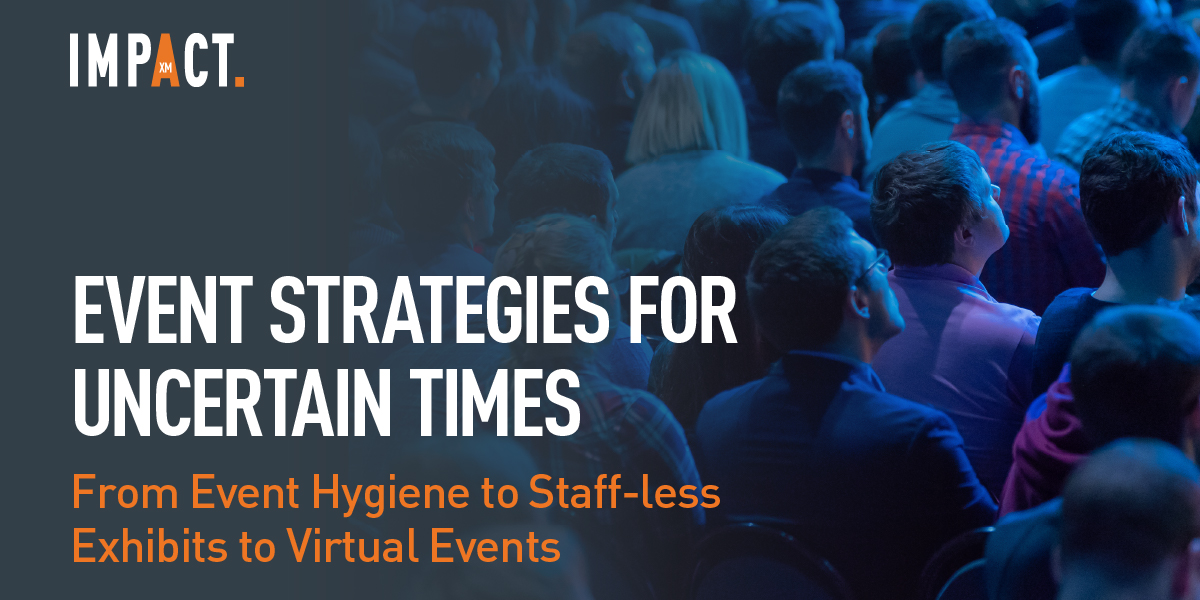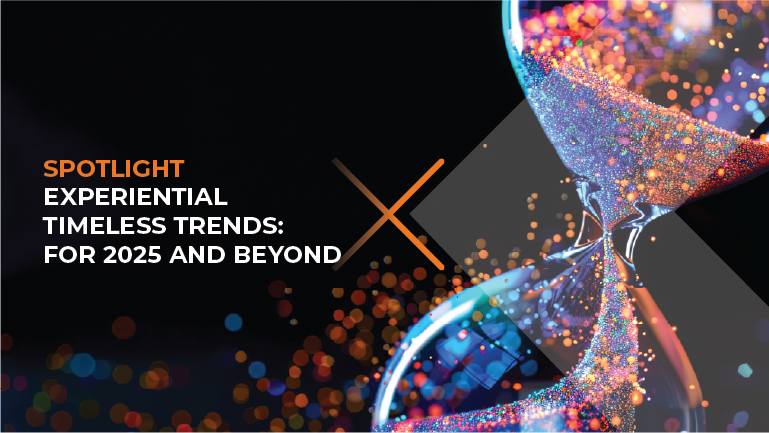As all of us in the event business attempt to make sense of the current state of health concerns, there are several strategies we can employ to continue business and reduce risk.
The arrival of Coronavirus, or COVID-19, has already had a large impact on the event and experiential marketing industry. Although no one can predict the future, there are ways to navigate uncertainty and help our companies and staff stay safe. This includes rethinking our traditional approach to events as well as providing alternative solutions to a live presence when shows are canceled, or we decide not to attend.
Mixed Organizer Response
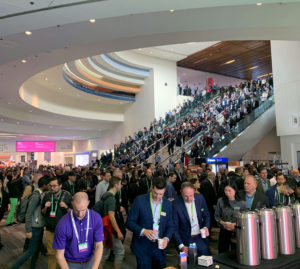
Recently we witnessed a variety of reactions by event producers and exhibitors. Some well-known events were cancelled including Mobile World Congress in Barcelona (2019 attendance ~110,000), the Facebook Developers Conference in San Francisco (2019 attendance ~5,000) and HIMSS in Orlando (2019 attendance ~40,000). However, some other equally well-known events were held including RSA in San Francisco (2019 attendance ~45,000) despite cancellations from major exhibitors, such as IBM, AT&T, and Verizon. And the cancellations of Sony and Kojima didn’t deter the game developer convention PAX East in Boston from opening their doors last month for a sold out weekend. Some organizer responses include postponement of events to the summer and fall. At the time of this writing, we are seeing some resilience in medical and healthcare conferences.
Event producers and exhibitors are monitoring the situation, weighing risks, and making their own informed decisions. With that in mind, here are some ideas to help manage risk while continuing to market for different levels of company responses – from normal event operations, to travel-impacted events, to alternatives to a cancelled event.
Event Still On? Avoid the Handshake, Find Some Liberian Inspiration
Doctors claim that around 80% of all cold, flu, and respiratory infections are transmitted from hand contact.1 Yet at events the handshake is as prevalent as the power lunch. Amidst the current state of affairs, some convention centers are encouraging “social distancing” with a no-handshake policy coupled with recommendations to stand a minimum of 3’ from other people.2
Since the beginning of civilization, human contact through customs like handshakes have been important to build trust. This continues today in all walks of life, especially business. An alternative approach is to train your staff to use the “Liberian Elbow Exchange” – an elbow bump greeting between people that got its name from Liberians who were successfully trained to avoid shaking hands during an Ebola outbreak. This practice transmits far less unwanted viruses than shaking hands or even fist bumps.3
Other steps for Event Hygiene:
- Remember the basics and remind your staff. Good preventive hygiene is as simple as frequently washing hands with soap and water, avoid touching your face, cough into your elbow (not your hand), and keep your immune system strong by eating healthy and getting enough sleep. All of these basic habits are known to help reduce your chance of infection with any transmittable virus.
- Make sure your staff is healthy. Anyone who appears to have any symptoms should be checked out by a medical professional before traveling or working in event areas.
- Consider eliminating non-packaged hospitality services. Use pre-packaged, individual serving-size hospitality, like bottled water or power bars. Have serving staff wear gloves when distributing hospitality items.
- Have hand sanitizer available in your event spaces. Note that although hand sanitizing products have come under scrutiny from the FDA on their claims of killing certain viruses, they have been proven to reduce the amount of a virus that can cling to your hand and therefore offers some protection.4
- For computer demos where staff and attendees need to touch screens or keyboards, consider touchless interface technology that allows you to control the presentation with hand or finger motions. This avoids any contact transmission and also makes your presentation very “Minority Report” like– the futuristic movie with Tom Cruise that imagined this touchless concept.
- Forget the face masks. “The CDC does not recommend that people who are well wear a facemask to protect themselves from respiratory diseases.”6 Face masks are for people that are already sick, so it would be fruitless, let alone off-putting, for your staff to wear masks.
- Perform periodic and thorough wipe downs of the event space including counters, keyboards, chairs, tables, etc., every hour or so with a strong cleaning product that kills germs and viruses. For some events, it may make sense to bring in a company like CrowdRX, a physician-led organization that delivers medical services at events. “We go into arenas and stadiums and theaters, routinely but especially during flu season, and offer disinfecting services using an electrostatic disinfecting machine. It’s a custom product that Clorox has developed that covers 360 degrees of the entire place. You’re just walking around spraying things and a little particulate is charged with electrostatic energy — it’s actually going to stick to the surface — so we can disinfect an entire large theater in under an hour”5
- If you have speakers using microphones on an on-going basis, it is highly recommended they are assigned a specific lavalier microphone to use for the event or show that no one else can use. Avoid handheld microphones for the obvious reasons.
Be transparent and discuss the elephant in the room. Use event signage that reminds attendees of the risk and presents information on proper hand washing, personal space, and suggestions on channeling the Liberian elbow bump.
No Staff? Borrow Some Disruption.
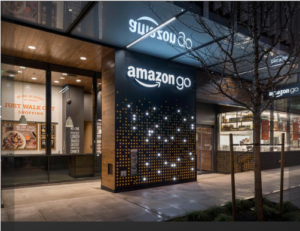
So, the conference is still on, but your company has mandated no one can travel to the show. How can your brand still be present at the event and make an impact? Look to one of the biggest disruptors in business for some inspiration. Amazon has opened a store that operates without any staff and uses facial recognition for transactions.7
From our research on event attendee behavior, Impact XM knows that many attendees would be just as happy to browse an exhibit without being escorted by a salesperson – until they have a question. If you are challenged with fielding a full staff for an event due to travel restrictions, consider a quasi-Amazon approach. Make your event space or exhibit a “self-service” journey where attendees can curate their own brand experience through your various resources, demos, and displays that offer intuitive attendee-driven access to information. (Many times this can be accomplished with your existing exhibit assets).
If you can staff with a local representative or two, great, otherwise use hired and trained local brand concierges to assist visitors. If a visitor does have a question or wants to know more, use some of the new co-presence technologies on the market that can connect interested attendees to your remote sales representatives or product experts via video screens or holographic displays in the event space.
If the event has not been cancelled but your company has restricted travel, exhibitors will have to make informed business decisions on whether to totally cancel their exhibit presence and be “out of sight and out of mind” to attendees, or whether some minimal brand presence, perhaps similar to the described self-service model, will provide some brand awareness benefit.
The Event is Cancelled? Consider Cyberspace.
Whether for a show you were exhibiting at, or an event your company was planning, cyberspace is proving to be a safe haven for many companies. The convention is cancelled, but you want to capture the momentum and narrative of the event with your targeted audience. One possibility is to move your exhibit to cyberspace with a virtual booth.
A virtual booth is a web-based, 3D environment that combines on-demand and self-service access to information designed within a “browse-able” and interactive environment, much like a live exhibit.
Virtual booths are not new, but recent software has made the experience richer and deeper. Eschewing the predictable “flat” virtual exhibits from the past, we recommend building in more of a 3D gaming environment feel to make navigation more natural and compelling.
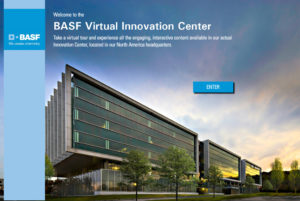 Using the virtual booth as an interface, the visitor can:
Using the virtual booth as an interface, the visitor can:
- Navigate in and around the exhibit
- Use chat or co-presence video tools to activate sales or product experts
- Link to a variety of digital resources such as web/videos/digital/social
- Provide a virtual briefcase for information requests
- Coordinate thought-leader presentations (from your company or industry experts) that can be delivered live in the virtual booth through co-presence technology
In employing this strategy, you will also want to build a campaign to drive traffic to the virtual booth. Although the event cancelled, you can partner with the association who owns the event to buy customer lists, link off their website, and publish content that will get attention and drive traffic. Consider using social media to let people know your company is open for business regardless of the event being cancelled.
When things return to normal, the virtual booth is an engaging way to give your company a hybrid strategy that can include both live and virtual options. Use the virtual booth to offer a preview/tour of your exhibit before and after an event. In addition, a virtual booth helps to extend the event experience beyond the “live exhibit dates” and encourages browsing to immerse customers for longer interactions. The virtual booth can become a “go to” place for what’s new with your company – whether in context with an event or not. The virtual booth is a technology-forward way to excite event attendees and avoid FOMO from industry events.
Hybrid Proprietary Events
Proprietary events and meetings are also feeling the negative impact of Covid-19, with several being canceled or postponed. The risk of full cancelation, or indefinite postponement, is a negative impact to both your long and short term business success. Rather than canceling, there are more thoughtful strategies you can undertake to continue the momentum you’ve built over the past few years.
Taking a hybrid approach, with local attendees in one or more locations, and your full audience connected through online platforms, can actually boost meeting success. This strategy requires less travel and lower accommodation costs while keeping the positive aspects of face-to-face meetings and content delivery intact. Executed well, it can actually boost overall attendance and ROI within your event strategy by opening your event and content to a much wider audience than have previously attended.
It’s important to think beyond “just” taking your proprietary event online, including attracting the right audiences, when to synchronize live keynotes or when to archive. The good news is there are many established technology approaches that can help move your meeting or event partially or fully online. For the online aspects of the event, there are proven platforms that can be orchestrated to deliver and amplify the important elements of meetings including conference sessions, breakouts and even virtual sponsorship exhibits. These tools allow for live Q&A, annotated presentations,social amplification and even gamification.
And like virtual exhibits, when normalcy returns, the virtual event platform can support a broader hybrid event strategy, optimizing both your live and virtual events into a highly effective machine.
Punctuated Equilibrium and the “New Normal”
Punctuated equilibrium is when the status quo is “punctuated” by sudden events that lead to permanent change. Sometimes it is world events, similar to Covid-19, that will drive a permanent change in how we behave. Besides staying safe and coming out of this current challenge successfully, we can all learn new ways to approach events differently. It could be our approach to event hygiene, different staffing models and disruptive co-presence models, and maybe more integration with virtual worlds.
Joan Eisenstodt from Meeting Professional International believes the Coronavirus is a “wakeup call” that points to the need for the meeting industry to be proactive rather than reactive regarding crises of any kind.
“There are steps we should always be taking in order to protect attendees,” says Eisenstodt, noting that previous crises such as the SARS epidemic in the early 2000s should have prompted permanent precautions. “A lot of it is the usual stuff which may seem silly but isn’t at all—providing hospital-grade wipes, reminding people to wash their hands and to refrain from hugging or shaking hands. You can do this with firmness but with some humor from a mainstage.”8
In the end, we are tribal beings that need the human physical connection in life and business, so we expect to see ourselves back at events over the long term.
Impact XM hopes everyone stays safe during these challenging times.
Definitions
VIRTUAL EVENT
A virtual event is more than online content. It’s a programmed experience with interactivity, live speakers, and networking, just like in-person events, but instead of a ballroom, the venue is an online platform. You are able to accommodate multiple presenters, even remotely, let attendees interact with the speakers, content and each other, gather audience intelligence through platform analytics and extend the engagement with on-demand content following the event.
WEBINAR
A webinar is a smaller online event that turns a presentation or demo into an either recorded or real-time conversation. Webinars allow participants to engage in an online discussion. Webinars can be broadcast using existing video conference platforms or tied into a larger virtual conference or event. Webinars are a successful way to present content. Studies show the average viewing time for a webinar is 61 minutes.
VIRTUAL EXHIBITS
A virtual exhibit is a cloud-based, 3D environment that combines on-demand and self-service access to information designed within a “browsable” and interactive environment similar to a live or physical exhibit. Virtual exhibits are an important complimentary counterpart to physical trade show. They are decoupled from space, time, and location restriction and allow visitors anywhere on the globe to access your exhibit experience on a 24/7/365 basis
References
1. Arbogast, James W, et al. “Impact of a Comprehensive Workplace Hand Hygiene Program on Employer Health Care Insurance Claims and Costs, Absenteeism, and Employee Perceptions and Practices.” Journal of Occupational and Environmental Medicine, Lippincott Williams & Wilkins, June 2016, www.ncbi.nlm.nih.gov/pmc/articles/PMC4883643/.
2. Event Marketer. “Amidst Covid-19 Cancellations, Venues Take Health Measures.” Event Marketer, Event Marketer, 3 Mar. 2020, www.eventmarketer.com/article/event-cancellations-venues-health-safety-covid-19/.
3. Silver, Marc. “The Liberian Elbow Bump Is Your Good Friend During Flu Season.” NPR, NPR, 3 Feb. 2018, www.npr.org/sections/goatsandsoda/2018/02/03/581805417/the-liberian-elbow-bump-is-your-good-friend-during-flu-season.
4. Gupta, Dr. Sanjay. “Does Hand Sanitizer Kill Bacteria and Viruses?” CNN, Cable News Network, 7 May 2009, thechart.blogs.cnn.com/2009/05/07/does-hand-sanitizer-kill-bacteria-and-viruses/.
5. Shea, Kait. “The Wuhan Coronavirus and Events: What You Need to Know.” Event Marketer, Event Marketer, 24 Feb. 2020, www.eventmarketer.com/article/the-wuhan-coronavirus-and-events-what-you-need-to-know/.
6. “Prevention, Treatment of Coronavirus Disease 2019 (COVID-19).” Centers for Disease Control and Prevention, Centers for Disease Control and Prevention, 15 Feb. 2020, www.cdc.gov/coronavirus/2019-ncov/about/prevention-treatment.html.
7. TodayShow. “Amazon Opens 1st Store without Checkout Lines or Cashiers.” TODAY.com, 25 Feb. 2020, www.today.com/food/amazon-opens-its-1st-store-without-checkout-lines-or-cashiers-t174611.
8. Staff, Editorial. “The Coronavirus and Meetings: Staying Alert and Prepared.” CEIR Blog, 7 Feb. 2020, ceirblog.wordpress.com/2020/02/09/the-coronavirus-and-meetings-staying-alert-and-prepared/.
9. Bizjournals.com, www.bizjournals.com/dallas/news/2020/02/07/7-eleven-is-tes


